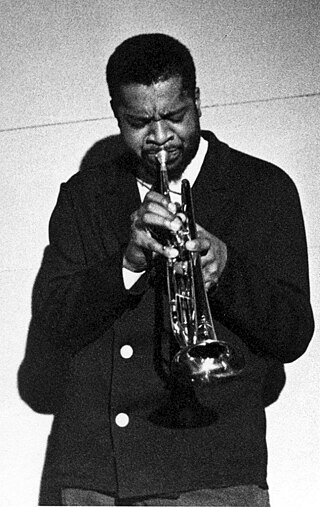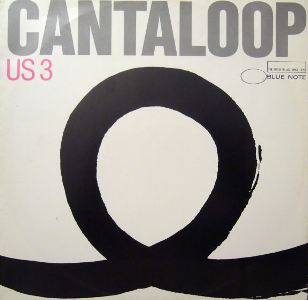
Funk is a music genre that originated in African-American communities in the mid-1960s when musicians created a rhythmic, danceable new form of music through a mixture of various music genres that were popular among African-Americans in the mid-20th century. It deemphasizes melody and chord progressions and focuses on a strong rhythmic groove of a bassline played by an electric bassist and a drum part played by a percussionist, often at slower tempos than other popular music. Funk typically consists of a complex percussive groove with rhythm instruments playing interlocking grooves that create a "hypnotic" and "danceable" feel. It uses the same richly colored extended chords found in bebop jazz, such as minor chords with added sevenths and elevenths, and dominant seventh chords with altered ninths and thirteenths.

Herbert Jeffrey Hancock is an American jazz musician, bandleader, and composer. Hancock started his career with trumpeter Donald Byrd's group. He shortly thereafter joined the Miles Davis Quintet, where he helped to redefine the role of a jazz rhythm section and was one of the primary architects of the post-bop sound. In the 1970s, Hancock experimented with jazz fusion, funk, and electro styles, using a wide array of synthesizers and electronics. It was during this period that he released perhaps his best-known and most influential album, Head Hunters.
Jazz rap is a fusion of jazz and hip hop music, as well as an alternative hip hop subgenre, that developed in the late 1980s and early 1990s. AllMusic writes that the genre "was an attempt to fuse African-American music of the past with a newly dominant form of the present, paying tribute to and reinvigorating the former while expanding the horizons of the latter." The rhythm was rooted in hip hop over which were placed repetitive phrases of jazz instrumentation: trumpet, double bass, etc. Groups involved in the formation of jazz rap included A Tribe Called Quest, Digable Planets, De La Soul, Gang Starr, The Roots, Jungle Brothers, and Dream Warriors.

Jazz fusion is a popular music genre that developed in the late 1960s when musicians combined jazz harmony and improvisation with rock music, funk, and rhythm and blues. Electric guitars, amplifiers, and keyboards that were popular in rock and roll started to be used by jazz musicians, particularly those who had grown up listening to rock and roll.

Donaldson Toussaint L'Ouverture Byrd II was an American jazz and rhythm & blues trumpeter and vocalist. A sideman for many other jazz musicians of his generation, Byrd was one of the few hard bop musicians who successfully explored funk and soul while remaining a jazz artist. As a bandleader, Byrd was an influence on the early career of Herbie Hancock and many others.

Acid jazz is a music genre that combines elements of funk, soul, and hip hop, as well as jazz and disco. Acid jazz originated in clubs in London during the 1980s with the rare groove movement and spread to the United States, Western Europe, Latin America and Japan. Acts included The Brand New Heavies, Incognito, James Taylor Quartet, Us3, and Jamiroquai from the UK, and Guru, Buckshot LeFonque and Digable Planets from the U.S. The rise of electronic club music in the middle to late 1990s led to a decline in interest, and in the twenty-first century, acid jazz became indistinct as a genre. Many acts that might have been defined as acid jazz are seen as jazz-funk, or nu jazz.

Soul jazz or funky jazz is a subgenre of jazz that incorporates strong influences from hard bop, blues, soul, gospel and rhythm and blues. Soul jazz is often characterized by organ trios featuring the Hammond organ and small combos including saxophone, brass instruments, electric guitar, bass, drums, piano, vocals and electric organ. Its origins were in the 1950s and early 1960s, with its heyday with popular audiences preceding the rise of jazz fusion in the late 1960s and 1970s. Prominent names in fusion ranged from bop pianists including Bobby Timmons and Junior Mance to a wide range of organists, saxophonists, pianists, drummers and electric guitarists including Jack McDuff, Eddie "Lockjaw" Davis, and Grant Green.
Nu jazz is a genre of jazz and electronic music. The music blends jazz elements with other musical styles, such as funk, electronic music, and free improvisation.
Popular music of the United Kingdom in the 1980s built on the post-punk and new wave movements, incorporating different sources of inspiration from subgenres and what is now classed as world music in the shape of Jamaican and Indian music. It also explored the consequences of new technology and social change in the electronic music of synthpop. In the early years of the decade, while subgenres like heavy metal music continued to develop separately, there was a considerable crossover between rock and more commercial popular music, with a large number of more "serious" bands, like The Police and UB40, enjoying considerable single chart success.
Broken beat is an electronic dance music genre characterized by syncopated beats and tense rhythms, including staggered or punctuated snare beats and/or hand claps. It has been heavily influenced by styles such as jazz-funk and R&B. Artists in this area typically emerged from the drum and bass, house, hip hop, techno or acid jazz scenes.

Gilles Jérôme Moehrle MBE, better known as Gilles Peterson, is a French broadcaster, DJ, and record label owner. He founded the influential labels Acid Jazz and Talkin' Loud, and started his current label Brownswood Recordings in 2006. He was awarded an honorary MBE in 2004, the AIM Award for Indie Champion and the Mixmag Award for Outstanding Contribution To Dance Music in 2013, the PRS for Music Award for Outstanding Contribution to Music Radio in 2014, and The A&R Award from the Music Producers Guild in 2019.
Rare groove is music that is very hard to source or relatively obscure. Rare groove is primarily associated with funk, R&B and jazz funk, but is also connected to subgenres including jazz rock, reggae, Latin jazz, soul, rock music, northern soul, and disco. Vinyl records that fall into this category generally have high re-sale prices. Rare groove records have been sought by not only collectors and lovers of this type of music, but also by hip hop artists and producers.

"Cantaloop (Flip Fantasia)" is a song by British jazz-rap group Us3, originally released in October 1992 by Blue Note Records as the lead single from the group's debut album, Hand On the Torch (1993). The song was recorded as a demo a year before the group's first release and features a sample of Herbie Hancock's song "Cantaloupe Island". Another sample, the announcement by Pee Wee Marquette, is taken from the Blue Note album A Night at Birdland, Vol. 1 by The Art Blakey Quintet. "Cantaloop (Flip Fantasia)" did not chart in the group's native UK, but in the US, it reached No. 9 and 7 on the Billboard Hot 100 and Cash Box Top 100, becoming the group's only top 40 single. It was subsequently re-released in UK where it peaked at No. 23. The song was certified gold by the Recording Industry Association of America (RIAA) on March 25, 1994 for selling over 500,000 copies.
The Mizell Brothers were an American record producing team in the 1970s, consisting of Larry Mizell and Alphonso "Fonce" Mizell. They worked together on a string of jazz fusion, crossover jazz, soul, R&B and disco records.

Robbie Vincent is an English radio broadcaster and DJ. As a champion of jazz, funk and soul music in the UK during the late 1970s he made an important contribution both live in clubs and on radio. In 1995 he was voted Independent Radio Personality of the Year at the Variety Club of Great Britain annual awards.
Radio Invicta was a pirate radio station that broadcast to London, and was the first of its kind to specialise in playing soul music. It broadcast from December 1970 to July 1984, and was known by its slogan Soul over London and considered itself "Europe's first and only all soul station".
Boogie is a rhythm and blues genre of electronic dance music with close ties to the post-disco style, that first emerged in the United States during the late 1970s to mid-1980s. The sound of boogie is defined by bridging acoustic and electronic musical instruments with emphasis on vocals and miscellaneous effects. It later evolved into electro and house music.
Neil Rushton is a British journalist, DJ, record dealer, record label entrepreneur, event promoter and author who is closely associated with the Northern soul scene.
Colin Curtis is a British DJ whose career spans several decades and musical developments.
Shaun Williams is a DJ and jazz dancer from Birmingham, United Kingdom, notable for his pioneering role in the UK's jazz fusion and electro music scenes. He achieved success with the early electro club track, released with DSM, "Warrior Groove".









